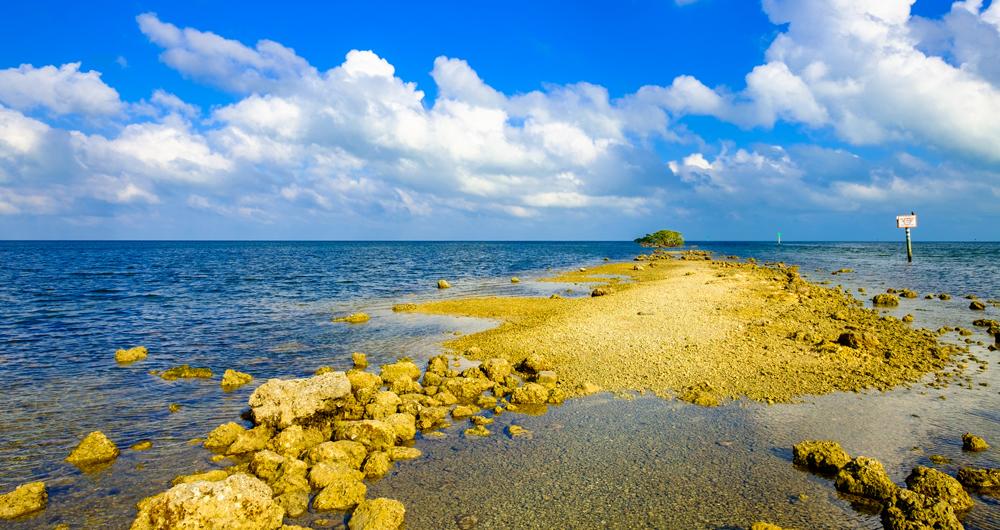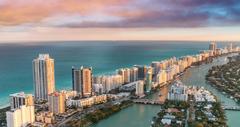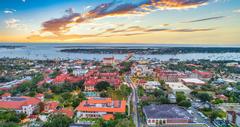A national park in southern Florida, Biscayne National Park protects the Biscayne Bay and its barrier reefs offshore. Ninety-five percent of the park is water and it is home to a large mangrove forest. The park preserves four different ecosystems: Biscayne Bay's shallow waters, the offshore Florida Reef, the coral limestone keys, and the mangrove swamp along the shoreline. The land was first established as Biscayne National Monument by President Lyndon B. Johnson in 1968, and the later redesignated as Biscayne National Park in 1980.
The park was created for its natural history, however, evidence of people and the ways they used the water and land can be found throughout the park. Shipwrecks bearing signs of once a violent time in history can be seen underwater. Visitors can relax in a rocking chair on the Dante Fascell Visitor Center's front porch and listen to the tale of how Biscayne National Park came to be by one of the people who helped make it happen.
Convoy Point and the Dante Fascell Visitor Center

The first stop for any visitor to Biscayne National Park should be the Dante Fascell Visitor Center. Located at Convoy Point, the Visitor Center is nine miles east of Homestead, Florida. Inside the center is a museum that provides visitors with a virtual journey through the park's ecosystems using video, audio, and dioramas. There are many films available in the auditorium to teach about the park.
The Visitor Center's Touch Table offers kids and adults alike the chance to feel for corals, bones, sponges, feathers, and more. The Gallery features local artists who works are inspired by the park. The bookstore in the Dante Fascell Visitor Center sale a variety of educational items. A park ranger or volunteer also is always available to answer questions or help visitors plan their visit.
Boca Chita Key
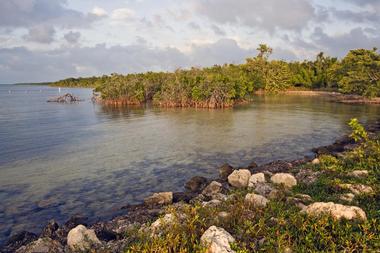
Boca Chita Key, Biscayne National Park's most popular island, offers a variety of facilities for visitors. A campground is available with barbecue grills and picnic tables. There are more barbecue grills and picnic table near the open-air pavilion on the south side of the harbor. Saltwater toilets are also provided at the campground, but there are no showers or sinks due to there being no electricity or freshwater on the island. Just east of the restrooms is a short hiking trail, only half of a mile long. The trail winds its way to the southern end of Boca Chita Key, and then curves back to towards the north. The trail emerges near the picnic area and pavilion.
The highlight of Boca Chita Key is its 65-foot ornamental lighthouse, which is the de facto symbol of Biscayne National Park. The lighthouse was built by one of the former owners of the island, Mark Honeywell, in the 1930's. It's open intermittently whenever park volunteers or staff are on the island. The observation deck of the lighthouse offers a spectacular view of the bay, islands, and ocean. Visitors can also get a glimpse of the Miami Beach, Key Biscayne, and Miami skylines.
Elliott Key
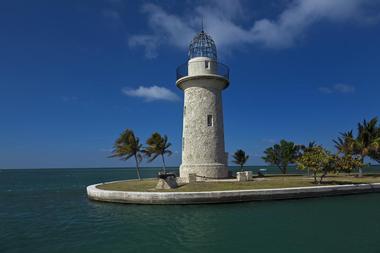
Biscayne National Park's largest island, Elliott Key, at one time was a thriving community of pioneers that took part in wrecking, sponging, and pineapple farming among other pursuits. The island now offers picnicking, hiking, camping, wildlife viewing, and swimming to visitors. Visitors can view several habitats in the maritime forest along Spite Highway, which runs about six miles through the center of Elliott Key. Swimming is permitted just north of the harbor on Elliott Key's bay side in the designated swim area. Wearing shoes at all times is recommended due to the shoreline's rocky environment. Fishing is allowed south of the harbor off of the maintenance dock, as well as outside of the swimming area and no-wake zone along the shoreline. Starting on the island's bay side is a mile-long trail, found at the campground's north end.
The campground can be found on the Elliott Key's bay side between the hammock edge and to within twenty-five feet of the harbor. Camping on the island is on a first-come, first-serve basis. Within the campground is a campsite for groups that provides picnic tables and barbecue grills, located about one-third of a mile from the harbor on the island's east side. Also on the Elliott Key's east side, next to the group campsite, is a fire ring. This is the only spot in Biscayne National Park where an open ground fire is allowed. There are additional barbecue grills and picnic tables provided around the harbor and throughout the campgrounds. Restrooms are also available with cold water showers. Visitors are advised to bring their own freshwater, just in case the generator for the fresh drinking water outside the restroom building should go down.
Adams Key
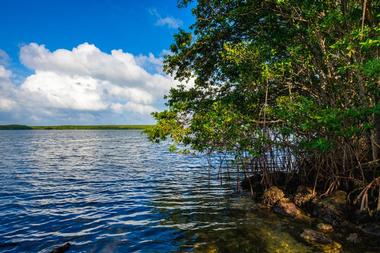
North of the fast-moving Caesar Creek is Adams Key. Which at one time was the home of the famous Cocolobo Club. This club was a retreat for people like Gar Wood, Carl Fisher, and Presidents Nixon, Johnson, Hoover, and Harding. Today, Adams Key is an area for visitors to relax at for the day. Leading through the hardwood hammock is a short trail. Toilets and a picnic pavilion are also provided, and there are two park ranger families who live on the island.
Guided Tours

Biscayne National Park offers guided boat tours on select Thursdays, Fridays, Saturdays, and Sundays that leave from the Dante Fascell Visitor Center. The boat tours, guided by the park, take place aboard the Pelican Skipper, a comfortable, 45-foot power catamaran. Visitors can delight in the spectacular scenery while learning about the ecosystems, wildlife, and history of Biscayne National Park. Each tour features a chance to explore the scenic and popular Boca Chita Key, as well as the park's historic and iconic lighthouse within the three hours. A boat tour ticket also grants visitors same-day admission to Homestead Bayfront Park.
Full-day sailing trips are offered from the Dante Fascell Visitor Center through Island Dreamer Sailing. During the six hour trip, passengers have the opportunity for island hiking, sailing, swimming, paddle boarding, kayaking, and snorkeling in Biscayne National Park. Passengers also have the chance to learn about the flora and fauna, dolphins, sea turtles, and manatees that live in the waters of Biscayne Bay.
Boating and Camping in Biscayne National Park
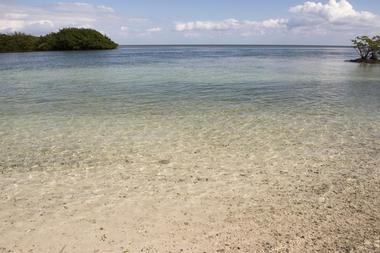
One of the best ways to explore Biscayne National Park is by boat. By boating through the park, visitors can discover living coral reefs, visit the Florida Keys, and explore Biscayne Bay's protected waters. Access for boaters is provided by four nearby country marinas.
It's possible for visitors to camp in Biscayne National Park, with campgrounds provided at Elliott Key and Boca Chita Key. Camping is on a first-come, first-serve basis, and the only way to get to these islands is by boat. The most popular island in the park is Boca Chita Key. There is an open, grassy, waterside camping area with grills and picnic tables on the island. Toilets are also provided, however, there are no showers, sinks, or drinking water.
The largest island in Biscayne National Park, Elliott Key, offers camping areas both in the forest and near the water. Grills and picnic tables are also available. Cold water showers, sinks, and toilets are also provided. Drinking water is available, however, visitors are advised to bring their own in case the system should go down. Tunneling through the tropical hardwood hammock of Elliott Key are two trails. One trail is a one-mile loop near the harbor. The other tail travels the entire length of the island, seven miles one-way or fourteen miles round-trip.
Kayaking and Canoeing
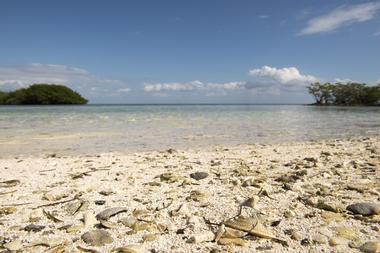
Kayaking and canoeing are excellent ways to explore Biscayne National Park's mangrove-fringed shorelines and the Biscayne Bay's shallow waters. A popular starting point for visitors wanting to explore the waters south of Caesar Creek is Adams Key. More experienced kayakers, however, might enjoy crossing the seven mile expanse of Biscayne Bay to camp at Boca Chita Key or Elliott Key. Using the islands as a base camp will allow visitors to explore the channels, creeks, and lagoons south of Caesar Creek. It's likely that kayakers and canoeists will have these waters to themselves due to many areas being much too shallow for motorized vessels.
Shallow Jones Lagoon offers a chance for visitors to spot large wading birds, large schools of fish, upside-down jellies, rays, and sharks. Within the lagoon is a bird rookery that kayakers and canoeists should be careful not to disturb. Another great spot is Hurricane Creek, providing amazing snorkeling underneath mangrove roots to view crabs, sea squirts, and anemones among other marine life. Giant sponges and rocky ledges offer hiding spots for spiny lobsters.
Visitors with their own kayaks or canoes can launch them at the Dante Fascell Visitor Center for free. Kayak and paddle board rentals are available at Convoy Point, where the visitor center is located, on the weekends. Paddling trail guides are available online and at the visitor center for the Black Point, Crocodile Creek, Deering, Elliott Key, Mowry Canal and Jones Lagoon trails. Website, Map


